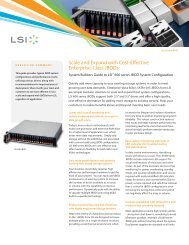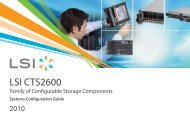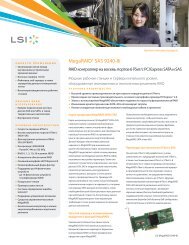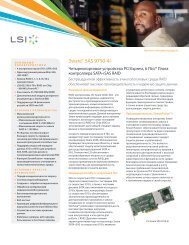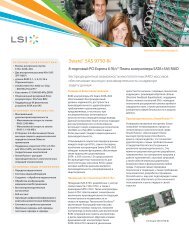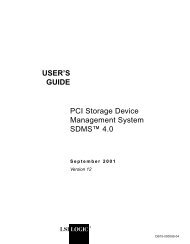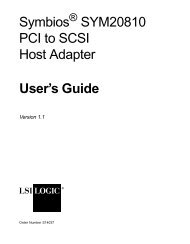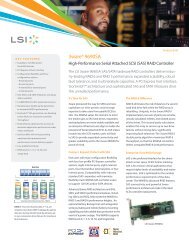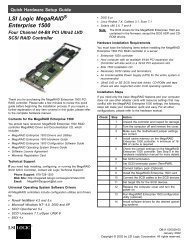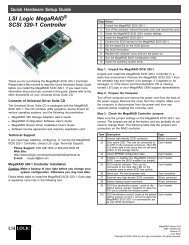MegaRAID SAS Device Driver Installation User's Guide - LSI
MegaRAID SAS Device Driver Installation User's Guide - LSI
MegaRAID SAS Device Driver Installation User's Guide - LSI
You also want an ePaper? Increase the reach of your titles
YUMPU automatically turns print PDFs into web optimized ePapers that Google loves.
USER’S<br />
GUIDE<br />
<strong>MegaRAID</strong> ® <strong>SAS</strong><br />
<strong>Device</strong> <strong>Driver</strong> <strong>Installation</strong><br />
June 2009<br />
80-00163-01 Rev.D
ii<br />
This document contains proprietary information of <strong>LSI</strong> ® Corporation. The information<br />
contained herein is not to be used by or disclosed to third parties without<br />
the express written permission of an officer of <strong>LSI</strong> Corporation.<br />
<strong>LSI</strong> products are not intended for use in life-support appliances, devices, or<br />
systems. Use of any <strong>LSI</strong> product in such applications without written consent of<br />
the appropriate <strong>LSI</strong> officer is prohibited.<br />
Document 80-00163-01 Rev.D, June 2009<br />
This document describes revision/release 1.2 of <strong>LSI</strong> Corporation’s <strong>MegaRAID</strong><br />
<strong>Device</strong> <strong>Driver</strong> and will remain the official reference source for all<br />
revisions/releases of this product until rescinded by an update.<br />
<strong>LSI</strong> Corporation reserves the right to make changes to any products herein at<br />
any time without notice. <strong>LSI</strong> does not assume any responsibility or liability arising<br />
out of the application or use of any product described herein, except as expressly<br />
agreed to in writing by <strong>LSI</strong>; nor does the purchase or use of a product from <strong>LSI</strong><br />
convey a license under any patent rights, copyrights, trademark rights, or any<br />
other of the intellectual property rights of <strong>LSI</strong> or third parties.<br />
Copyright © 2006-2009 by <strong>LSI</strong> Corporation. All rights reserved.<br />
TRADEMARK ACKNOWLEDGMENT<br />
<strong>LSI</strong>, the <strong>LSI</strong> logo design, and <strong>MegaRAID</strong> are trademarks or registered<br />
trademarks of <strong>LSI</strong> Corporation. MS-DOS and Windows are registered trademarks<br />
of Microsoft Corporation. Novell and Netware are registered trademarks and<br />
SUSE is a trademark of Novell, Inc. Red Hat is a registered trademark of Red<br />
Hat, Inc. Linux is a trademark of Linus Torvalds. SCO and UnixWare are<br />
registered trademarks and OpenServer is a trademark of SCO Group, Inc.<br />
FreeBSD is a registered trademark of The FreeBSD Foundation. Solaris is a<br />
trademark of Sun Microsystems, Inc. All other brand and product names may be<br />
trademarks of their respective companies.<br />
CD<br />
To receive product literature, visit us at http://www.lsi.com.<br />
Copyright © 2006-2009 by <strong>LSI</strong> Corporation. All rights reserved.
Audience<br />
Organization<br />
Preface<br />
This manual is the primary reference for the operating system drivers<br />
provided with the <strong>LSI</strong> ® <strong>MegaRAID</strong> ® devices. It describes the drivers for<br />
all supported operating systems and explains how to install them.<br />
This document is intended for people installing an operating system<br />
driver for a <strong>MegaRAID</strong> <strong>SAS</strong> RAID controller.<br />
This document has the following chapters:<br />
• Chapter 1, Overview, describes the <strong>MegaRAID</strong> <strong>SAS</strong> RAID controller<br />
and lists the operating systems for which drivers are provided.<br />
• Chapter 2, Windows <strong>Driver</strong> <strong>Installation</strong>, provides installation<br />
instructions for Windows operating systems.<br />
• Chapter 3, Novell NetWare <strong>Driver</strong> <strong>Installation</strong>, provides installation<br />
instructions for Novell NetWare.<br />
• Chapter 4, Red Hat Linux 3.0, 4.0, and 5.0 <strong>Driver</strong> <strong>Installation</strong>,<br />
provides installation instructions for Red Hat Linux.<br />
• Chapter 5, SUSE Linux Enterprise Server (SLES) 9.0, 10.0, 11.0<br />
<strong>Driver</strong> <strong>Installation</strong>, provides installation instructions for SLES Linux.<br />
• Chapter 6, SCO OpenServer 6 and SCO UnixWare 7 <strong>Driver</strong><br />
<strong>Installation</strong>, provides installation instructions for SCO Openserver<br />
and SCO UnixWare.<br />
• Chapter 7, FreeBSD <strong>Driver</strong> <strong>Installation</strong>, provides installation<br />
instructions for FreeBSD.<br />
<strong>MegaRAID</strong> <strong>SAS</strong> <strong>Device</strong> <strong>Driver</strong> <strong>Installation</strong> User’s <strong>Guide</strong> iii<br />
Copyright © 2006-2009 by <strong>LSI</strong> Corporation. All rights reserved.
• Chapter 8, Solaris 10 x86 and Solaris Express x86 <strong>Driver</strong><br />
<strong>Installation</strong>, provides installation instructions for Solaris.<br />
<strong>MegaRAID</strong> System <strong>Installation</strong> Sequences and Document Organization<br />
The following table outlines the installation, configuration, and<br />
management sequences for a <strong>MegaRAID</strong> <strong>SAS</strong> RAID system. Each<br />
sequence consists of a series of steps and operations that the reference<br />
manual explains. <strong>LSI</strong> recommends performing the sequences in the<br />
order listed when you install and configure your <strong>SAS</strong> RAID system.<br />
Sequence Task Reference Manual<br />
1 Understand RAID system theory and operation. <strong>MegaRAID</strong> <strong>SAS</strong> Software User’s<br />
<strong>Guide</strong><br />
2 Install the <strong>MegaRAID</strong> <strong>SAS</strong> RAID controller and the<br />
related hardware.<br />
3 Configure the physical arrays and logical devices<br />
using either the <strong>MegaRAID</strong> Configuration Utility (CU)<br />
or the WebBIOS CU.<br />
iv Preface<br />
Copyright © 2006-2009 by <strong>LSI</strong> Corporation. All rights reserved.<br />
<strong>MegaRAID</strong> <strong>SAS</strong> RAID Controllers<br />
User’s <strong>Guide</strong><br />
<strong>MegaRAID</strong> 1078-based <strong>SAS</strong><br />
RAID Controllers User’s <strong>Guide</strong><br />
<strong>MegaRAID</strong> 6Gb/s <strong>SAS</strong> RAID<br />
Controllers User’s <strong>Guide</strong><br />
<strong>MegaRAID</strong> <strong>SAS</strong> Software User’s<br />
<strong>Guide</strong><br />
4 Install the <strong>MegaRAID</strong> <strong>SAS</strong> device drivers. <strong>MegaRAID</strong> <strong>SAS</strong> <strong>Device</strong> <strong>Driver</strong><br />
<strong>Installation</strong> User’s <strong>Guide</strong><br />
5 Use the WebBIOS CU or the <strong>MegaRAID</strong> Storage<br />
Manager tool to configure, monitor, and maintain storage<br />
configurations on <strong>LSI</strong> <strong>SAS</strong> controllers.<br />
The WebBIOS CU resides in the <strong>SAS</strong> controller BIOS<br />
and operates independently of the operating system.<br />
The <strong>MegaRAID</strong> Storage Manager graphical user interface<br />
(GUI) makes it easy for you to create and<br />
manage storage configurations. This tool runs under<br />
an operating system and can manage RAID arrays<br />
while the system is operating.<br />
<strong>MegaRAID</strong> <strong>SAS</strong> Software User’s<br />
<strong>Guide</strong>
Related Publications<br />
Conventions Used in This Manual<br />
<strong>MegaRAID</strong> <strong>SAS</strong> RAID Controllers User’s <strong>Guide</strong>,<br />
Document No. 80-00130-01 Rev. B<br />
This document explains how to install your <strong>MegaRAID</strong> 1068-based <strong>SAS</strong><br />
RAID controller in a host system. In addition, it provides the electrical and<br />
physical specifications, jumper definitions, and connector locations for<br />
the 1068-based <strong>SAS</strong> RAID controllers.<br />
<strong>MegaRAID</strong> 1078-based <strong>SAS</strong> RAID Controllers User’s <strong>Guide</strong>,<br />
Document No. 80-00157-01 Rev. B<br />
This document explains how to install your <strong>MegaRAID</strong> 1078-based <strong>SAS</strong><br />
RAID controller in a host system. In addition, it provides the electrical and<br />
physical specifications, jumper definitions, and connector locations for<br />
the 1078-based <strong>SAS</strong> RAID controllers.<br />
<strong>MegaRAID</strong> 6Gb/s <strong>SAS</strong> RAID Controllers User’s <strong>Guide</strong>,<br />
Document No. 41450-01 Rev. A<br />
This document explains how to install your <strong>MegaRAID</strong> 6Gb/s <strong>SAS</strong> RAID<br />
controller in a host system. In addition, it provides the electrical and<br />
physical specifications, jumper definitions, and connector locations for<br />
the 6Gb/s <strong>SAS</strong> RAID controllers.<br />
<strong>MegaRAID</strong> <strong>SAS</strong> Software User’s <strong>Guide</strong>, Document No. 80-00156-<br />
01 Rev. G<br />
This document explains how to use the <strong>MegaRAID</strong> Storage Manager,<br />
WebBIOS, and Command Line Interface (CLI) utilities to configure,<br />
monitor, and maintain <strong>MegaRAID</strong> <strong>SAS</strong> RAID controllers and the storagerelated<br />
devices connected to them.<br />
Notation Example Meaning and Use<br />
→ Start → Programs. Used to indicate a series of selections in a GUI.<br />
all caps ALT+CTRL+DEL Key presses display in all capital letters.<br />
Preface v<br />
Copyright © 2006-2009 by <strong>LSI</strong> Corporation. All rights reserved.
Notation Example Meaning and Use<br />
Courier<br />
typeface<br />
bold<br />
typeface<br />
Revision History<br />
.nwk file Names of commands, directories, filenames, and on-screen text<br />
are shown in Courier typeface.<br />
fd1sp In a command line, keywords are shown in bold, non-italic typeface.<br />
Enter them exactly as shown.<br />
italics module In command lines and names, italics indicate user variables.<br />
Italicized text must be replaced with appropriate user-specified<br />
items. Enter items of the type called for, using lower case.<br />
initial capital<br />
letters<br />
Undo<br />
Edit<br />
Apply<br />
vi Preface<br />
Copyright © 2006-2009 by <strong>LSI</strong> Corporation. All rights reserved.<br />
Names of menu commands, options, check buttons, text<br />
buttons, options buttons, text boxes, list boxes, etc., are shown<br />
in text with initial capital lettering to avoid misreading. These<br />
elements may appear on your screen in all lower case.<br />
ellipses option... In command formats, elements preceding ellipses may be<br />
repeated any number of times. Do not enter the ellipses. In<br />
menu items, if an ellipsis appears in an item, clicking that item<br />
brings up a dialog box.<br />
Document Number Date Remarks<br />
80-00163-01 Rev. D June 2009 Updated the procedure for installing the FreeBSD<br />
operating system.<br />
80-00163-01 Rev. C April 2009 Updated the Solaris 10 operating system information<br />
and driver filenames.<br />
80-00163-01 Rev. B November 2008 Added installation instructions for the FreeBSD and<br />
Solaris 10 operating systems.<br />
80-00163-01 Rev. A August 2007 Updated the installation procedures for the Windows,<br />
Red Hat Linux, and SuSE Linux operating systems to<br />
include the latest versions. Added a chapter for the<br />
SCO operating system.<br />
DB15-000358-00 February 2006 Initial release of document.
Technical Support<br />
<strong>LSI</strong> provides technical support for products purchased directly from <strong>LSI</strong><br />
or from an <strong>LSI</strong>-authorized reseller only. For assistance in installing,<br />
configuring, or running your <strong>MegaRAID</strong> <strong>SAS</strong> RAID controller, contact <strong>LSI</strong><br />
Technical Support.<br />
Phone Support:<br />
1-800-633-4545 (North America)<br />
Web Site:<br />
http://www.lsi.com/support<br />
If the <strong>MegaRAID</strong> <strong>SAS</strong> RAID controller was installed as part of a system<br />
manufactured by a company other than <strong>LSI</strong>, or if you purchased an <strong>LSI</strong><br />
product from an unauthorized reseller, call the technical support<br />
department of the computer manufacturer or the unauthorized reseller.<br />
<strong>LSI</strong> does not provide direct technical support in these cases.<br />
Preface vii<br />
Copyright © 2006-2009 by <strong>LSI</strong> Corporation. All rights reserved.
viii Preface<br />
Copyright © 2006-2009 by <strong>LSI</strong> Corporation. All rights reserved.
Chapter 1<br />
Overview<br />
Contents<br />
1.1 <strong>Driver</strong> Description 1-1<br />
1.1.1 <strong>Driver</strong> Functions 1-2<br />
1.1.2 <strong>Driver</strong> Updates 1-2<br />
1.2 <strong>Driver</strong> Names 1-3<br />
Chapter 2<br />
Windows <strong>Driver</strong> <strong>Installation</strong><br />
2.1 Installing the Windows System <strong>Driver</strong> in a New Windows<br />
System 2-2<br />
2.2 Installing or Updating the <strong>MegaRAID</strong> <strong>Driver</strong> in an Existing<br />
Windows System 2-3<br />
Chapter 3<br />
Novell NetWare <strong>Driver</strong> <strong>Installation</strong><br />
3.1 Novell NetWare <strong>Driver</strong> Files 3-1<br />
3.2 Installing the NetWare <strong>Driver</strong> in a New NetWare System 3-2<br />
3.3 Installing or Updating the NetWare <strong>Driver</strong> in an Existing<br />
NetWare System 3-3<br />
Chapter 4<br />
Red Hat Linux 3.0, 4.0, and 5.0 <strong>Driver</strong> <strong>Installation</strong><br />
4.1 Installing the <strong>Driver</strong> in a New Red Hat Linux System 4-1<br />
4.1.1 Installing from CD 4-1<br />
4.1.2 Installing from a <strong>Driver</strong> Update Diskette 4-1<br />
4.2 Adding the Red Hat Linux 4.0 or 5.0 <strong>Driver</strong> to an Existing<br />
<strong>Installation</strong> 4-2<br />
4.3 Updating the Red Hat Linux System <strong>Driver</strong> 4-3<br />
Contents ix<br />
Copyright © 2006-2009 by <strong>LSI</strong> Corporation. All rights reserved.
Chapter 5<br />
SUSE Linux Enterprise Server (SLES) 9.0, 10.0, 11.0 <strong>Driver</strong> <strong>Installation</strong><br />
5.1 Installing the <strong>Driver</strong> in a New SuSE SLES Linux System 5-1<br />
5.1.1 Installing from CD 5-1<br />
5.1.2 Installing from a <strong>Driver</strong> Update Diskette 5-2<br />
5.2 Updating the SuSE SLES 9.0, 10.0, or 11.0 <strong>Driver</strong> 5-2<br />
Chapter 6<br />
SCO OpenServer 6 and SCO UnixWare 7 <strong>Driver</strong> <strong>Installation</strong><br />
6.1 Installing the <strong>Driver</strong> in a New SCO OpenServer 6 or SCO<br />
UnixWare 7 System 6-1<br />
6.2 Upgrading the <strong>Driver</strong> on an Existing OpenServer 6 or<br />
UnixWare 7 System 6-2<br />
Chapter 7<br />
FreeBSD <strong>Driver</strong> <strong>Installation</strong><br />
7.1 Upgrading the <strong>Driver</strong> on an Existing FreeBSD System 7-1<br />
Chapter 8<br />
Solaris 10 x86 and Solaris Express x86 <strong>Driver</strong> <strong>Installation</strong><br />
8.1 Installing the <strong>Driver</strong> in a New Solaris 10 x86 or Solaris<br />
Express x86 8-1<br />
8.1.1 Installing the <strong>Driver</strong> Update (Install-Time-Update)<br />
from a CD or a Diskette 8-1<br />
8.1.2 Installing the <strong>Driver</strong> Update (Install-Time-Update)<br />
from Floppy Diskette 8-2<br />
8.2 Updating the <strong>Driver</strong> on a Solaris 10 x86 or a Solaris<br />
Express x86 8-3<br />
Index<br />
Customer Feedback<br />
x Contents<br />
Copyright © 2006-2009 by <strong>LSI</strong> Corporation. All rights reserved.
Tables<br />
1.1 <strong>MegaRAID</strong> <strong>Device</strong> <strong>Driver</strong> Files 1-3<br />
3.1 <strong>MegaRAID</strong> Novell NetWare <strong>Driver</strong> Files 3-1<br />
Contents xi<br />
Copyright © 2006-2009 by <strong>LSI</strong> Corporation. All rights reserved.
xii Contents<br />
Copyright © 2006-2009 by <strong>LSI</strong> Corporation. All rights reserved.
Chapter 1<br />
Overview<br />
1.1 <strong>Driver</strong> Description<br />
This chapter provides an overview of the drivers for the <strong>MegaRAID</strong> ® <strong>SAS</strong><br />
RAID controllers. It consists of the following sections:<br />
• Section 1.1, “<strong>Driver</strong> Description”<br />
• Section 1.2, “<strong>Driver</strong> Names”<br />
Subsequent chapters in this manual provide detailed installation<br />
instructions for the operating systems. Use the latest updates provided<br />
by the operating system manufacturer and review the readme file that<br />
accompanies the driver for any updated information.<br />
You can install the <strong>MegaRAID</strong> <strong>SAS</strong> controller in any IBM AT-compatible<br />
computer that has a PCI Express local bus. The RAID controller can run<br />
under various operating systems.<br />
To use the controller with these operating systems, you must install<br />
software drivers. <strong>LSI</strong> ® provides software drivers for the following<br />
operating systems:<br />
• Microsoft ® Windows ® 2000, Windows XP, Windows XP x64,<br />
Windows Server 2003 (x86), Windows Server 2003 (x64), and<br />
Windows Vista<br />
• Novell ® NetWare ®<br />
• Red Hat ® Linux versions 3.0, 4.0, and 5.0<br />
• SuSE SLES versions 9.0, 10.0, and 11.0<br />
• SCO OpenServer ® and SCO UnixWare<br />
<strong>MegaRAID</strong> <strong>SAS</strong> <strong>Device</strong> <strong>Driver</strong> <strong>Installation</strong> User’s <strong>Guide</strong> 1-1<br />
Copyright © 2006-2009 by <strong>LSI</strong> Corporation. All rights reserved.
• FreeBSD ®<br />
• Solaris 10<br />
1.1.1 <strong>Driver</strong> Functions<br />
1.1.2 <strong>Driver</strong> Updates<br />
<strong>MegaRAID</strong> provides drivers for the <strong>MegaRAID</strong> <strong>SAS</strong> RAID controllers,<br />
which bring up to 6.0 Gb/s Serial Attached SCSI and 3.0 Gb/s SATA II<br />
performance to host adapter, workstation, and server designs. The<br />
controllers support internal and external storage devices, which allows<br />
you to use a system that supports enterprise-class <strong>SAS</strong> and desktopclass<br />
SATA II drives.<br />
The <strong>SAS</strong> controllers integrate eight high-performance <strong>SAS</strong>/SATA II PHYs<br />
and a PCI Express bus master DMA core. Each of the eight PHYs is<br />
capable of 6.0 Gb/s <strong>SAS</strong> link rates, and 3.0 Gb/s SATA II link rates.<br />
The <strong>SAS</strong> RAID controllers support the <strong>SAS</strong> protocol as described in the<br />
Serial Attached SCSI Standard, version 1.1. The controllers also support<br />
the Serial ATA II (SATA II) protocol defined by the Serial ATA<br />
specification, version 1.0a. SATA II is an extension to SATA 1.0a.<br />
The drivers do the following:<br />
• Support the PCI Express protocol<br />
• Support multiple RAID Storage Adapters (RSAs)<br />
• Provide the ability to see newly configured logical drives in the<br />
configuration software utility without rebooting the system<br />
• Allow random deletion of logical drives created using the <strong>MegaRAID</strong><br />
Storage Manager (see the <strong>MegaRAID</strong> <strong>SAS</strong> Software User’s <strong>Guide</strong><br />
for more information)<br />
• Support use of the remaining array capacity by <strong>MegaRAID</strong> Storage<br />
Manager<br />
Because <strong>LSI</strong> regularly updates device drivers, there might be a feature<br />
added to your driver that is not included in the most recent manual<br />
publication. If you have a question about a feature, consult the readme<br />
file that accompanies the driver, or contact your <strong>MegaRAID</strong> support<br />
1-2 Overview<br />
Copyright © 2006-2009 by <strong>LSI</strong> Corporation. All rights reserved.
1.2 <strong>Driver</strong> Names<br />
representative. Be sure to use the latest Service Packs provided by the<br />
operating system manufacturer.<br />
You can download the latest drivers and software on the <strong>LSI</strong> website at<br />
http://lsi.com/cm/DownloadSearch.do. Under the Download tab, select<br />
your product from the pull-down menu to display the latest drivers<br />
available for download.<br />
Table 1.1 lists the device driver files for <strong>MegaRAID</strong> controllers. The driver<br />
files are available on the Universal <strong>Driver</strong> Suite CD that accompanied<br />
your <strong>MegaRAID</strong> controller. <strong>LSI</strong> updates the <strong>MegaRAID</strong> device drivers<br />
frequently. To ensure you have the current version of this driver,<br />
download the driver from the <strong>LSI</strong> web site: http://www.lsi.com. See the<br />
readme file that accompanies the driver for any updated information.<br />
To make a driver diskette, extract the files from the Universal <strong>Driver</strong> Suite<br />
CD to a blank floppy diskette, or download the driver files from the <strong>LSI</strong><br />
website and extract them to an empty floppy diskette. Label the diskette<br />
as the <strong>MegaRAID</strong> driver diskette for the given operating system.<br />
Table 1.1 <strong>MegaRAID</strong> <strong>Device</strong> <strong>Driver</strong> Files<br />
Operating System <strong>Device</strong> <strong>Driver</strong> Filenames<br />
<strong>Installation</strong><br />
Reference<br />
Windows 2000 megasas.cat, megasas.sys, NODEV.INF, OEMSETUP.INF, TXTSETUP.OEM Chapter 2<br />
Windows XP megasas.cat, megasas.sys, NODEV.INF, OEMSETUP.INF, TXTSETUP.OEM<br />
Windows XP x64 megasas.cat, megasas.sys, NODEV.INF, OEMSETUP.INF, TXTSETUP.OEM<br />
Windows Server<br />
2003 (x86)<br />
msas2k3.cat, msas2k3.sys, NODEV.INF, OEMSETUP.INF, TXTSETUP.OEM<br />
Windows Server<br />
2003 (x64)<br />
msas2k3.cat, msas2k3.sys, NODEV.INF, OEMSETUP.INF, TXTSETUP.OEM<br />
Windows Vista (x64 megasas.cat, megasas.sys, NODEV.INF, OEMSETUP.INF, TXTSETUP.OEM<br />
and x86)<br />
Novell NetWare mega_sas.ddi, mega_sas.ham Chapter 3<br />
Red Hat Linux 3 megaraid_sas.o Chapter 4<br />
Red Hat Linux 4 megaraid_sas.ko<br />
Red Hat Linux 5 megaraid_sas.ko<br />
<strong>Driver</strong> Names 1-3<br />
Copyright © 2006-2009 by <strong>LSI</strong> Corporation. All rights reserved.
Table 1.1 <strong>MegaRAID</strong> <strong>Device</strong> <strong>Driver</strong> Files (Cont.)<br />
Operating System <strong>Device</strong> <strong>Driver</strong> Filenames<br />
SuSE Linux<br />
Enterprise Server 9<br />
megaraid_sas.ko Chapter 5<br />
SuSE Linux<br />
Enterprise<br />
Server 10<br />
megaraid_sas.ko<br />
SuSE Linux<br />
Enterprise<br />
Server 11<br />
megaraid_sas.ko<br />
SCO OpenServer,<br />
SCO UnixWare<br />
driver.o Chapter 6<br />
FreeBSD mfi.ko, Makefile, build.sh, mfi.c, mfireg.h, mfivar.h,<br />
mfi_cam.c, mfi_debug.c, mfi_disk.c, mfi_ioctl.h,<br />
mfi_linux.c, mfi_pci.c<br />
Chapter 7<br />
Solaris 10 For 82XX, 83XX, and 84XX <strong>SAS</strong> RAID controllers:<br />
mega_sas (32-bit), mega_sas (64-bit), mega_sas.conf<br />
For 87XX, 88XX, 96XX, and 98XX <strong>SAS</strong> RAID controllers:<br />
mr_sas (32-bit), mr_sas (64-bit), mr_sas.conf<br />
1-4 Overview<br />
Copyright © 2006-2009 by <strong>LSI</strong> Corporation. All rights reserved.<br />
<strong>Installation</strong><br />
Reference<br />
Chapter 8
Chapter 2<br />
Windows <strong>Driver</strong><br />
<strong>Installation</strong><br />
This chapter describes the installation of the following Windows ®<br />
operating systems:<br />
• Windows 2000<br />
• Windows XP<br />
• Windows XP x64<br />
• Windows Server 2003 (x86)<br />
• Windows Server 2003 (x64)<br />
• Windows Vista<br />
This chapter consists of the following sections:<br />
• Section 2.1, “Installing the Windows System <strong>Driver</strong> in a New<br />
Windows System”<br />
• Section 2.2, “Installing or Updating the <strong>MegaRAID</strong> <strong>Driver</strong> in an<br />
Existing Windows System”<br />
Note: When you connect an Engenio ® DM1300 to a <strong>SAS</strong> RAID<br />
controller and boot up the system to a Windows operating<br />
system, a message displays asking for a driver for the<br />
DM1300. You need to install the SES processor in the<br />
DM1300 by pointing to the same location where the<br />
<strong>MegaRAID</strong> ® driver package is located, the file Nodev.inf.<br />
The Nodev.inf file (in the driver package) has the entries<br />
required to install the processor correctly. This file supports<br />
the following enclosure IDs:<br />
Enclosure<strong>LSI</strong>LOGIC_____SYM3600-<strong>SAS</strong> and<br />
EnclosureIBM-ESXSEXP3000_________.<br />
<strong>MegaRAID</strong> <strong>SAS</strong> <strong>Device</strong> <strong>Driver</strong> <strong>Installation</strong> User’s <strong>Guide</strong> 2-1<br />
Copyright © 2006-2009 by <strong>LSI</strong> Corporation. All rights reserved.
2.1 Installing the Windows System <strong>Driver</strong> in a New Windows<br />
System<br />
Perform the following steps to install the <strong>MegaRAID</strong> device driver in a<br />
new Windows operating system. The Windows operating system<br />
automatically adds the driver to the registry and copies the driver to the<br />
appropriate directory.<br />
Step 1. Start the Windows installation by booting from the appropriate<br />
Windows CD-ROM.<br />
The system BIOS must support booting from a CD-ROM. BIOS<br />
settings might require changes to allow CD-ROM booting. See<br />
your system documentation.<br />
Step 2. Press F6 when the following displays at the bottom of the<br />
screen, unless you are installing Windows Vista:<br />
"Press F6 if you need..."<br />
Note: For the system to recognize the new driver for Windows<br />
2000, Windows XP, and Windows Server 2003, you must<br />
press F6. If you are installing Windows Vista, you do not<br />
need to press F6. For Windows Vista, after the first<br />
installation screen, an option displays to allow you to load<br />
the driver from either a floppy diskette or a USB key.<br />
Otherwise, it will load the default driver from the DVD.<br />
Step 3. Select “S” to specify an additional device when the<br />
screen displays:<br />
"Setup could not determine the type of one or more<br />
mass storage devices..."<br />
The system prompts for the manufacturer-supplied hardware<br />
support disk.<br />
Note: If the screen does not display this message after you press<br />
F6, then the setup program did not recognize the F6<br />
command. Reboot the system, and return to step 2.<br />
Step 4. Insert the driver diskette containing the Windows device driver<br />
and press ENTER.<br />
2-2 Windows <strong>Driver</strong> <strong>Installation</strong><br />
Copyright © 2006-2009 by <strong>LSI</strong> Corporation. All rights reserved.
Step 5. Select the appropriate <strong>MegaRAID</strong> adapter from the menu by<br />
using the arrow key to highlight it, and then press ENTER to<br />
proceed.<br />
Step 6. Press ENTER again to proceed.<br />
Step 7. Return to the Windows Setup screen.<br />
Windows displays a “Welcome to Setup” window.<br />
Step 8. Press ENTER to continue.<br />
Step 9. Press C to continue the Microsoft Windows installation<br />
procedure.<br />
Step 10. Follow the Windows installation procedure.<br />
Step 11. Repeat this process for all the adapters on your system.<br />
2.2 Installing or Updating the <strong>MegaRAID</strong> <strong>Driver</strong> in an<br />
Existing Windows System<br />
Perform the following steps to install or update the <strong>MegaRAID</strong> device<br />
driver in an existing Windows system:<br />
Step 1. Boot the Windows operating system.<br />
The Found New Hardware Wizard starts.<br />
Step 2. Click the Next button and insert the driver diskette into the A:\<br />
drive.<br />
Step 3. Click the Search for a Suitable <strong>Driver</strong>... button, and click Next.<br />
Step 4. Click the Next button.<br />
In some cases, a message displays saying that this driver is not<br />
digitally signed. This message informs you that a nonsigned<br />
driver is being installed. If this message displays, click Continue<br />
Anyway.<br />
Step 5. Select Floppy only, and then click the Next button in the <strong>Driver</strong><br />
Files Search Results window.<br />
Step 6. Click the Finish button to complete the driver installation, and<br />
then repeat this process for all the adapters on your system.<br />
Installing or Updating the <strong>MegaRAID</strong> <strong>Driver</strong> in an Existing Windows System 2-3<br />
Copyright © 2006-2009 by <strong>LSI</strong> Corporation. All rights reserved.
2-4 Windows <strong>Driver</strong> <strong>Installation</strong><br />
Copyright © 2006-2009 by <strong>LSI</strong> Corporation. All rights reserved.
Chapter 3<br />
Novell NetWare <strong>Driver</strong><br />
<strong>Installation</strong><br />
This chapter provides installation instructions for the <strong>MegaRAID</strong> ® Novell ®<br />
NetWare ® driver and consists of the following sections:<br />
• Section 3.1, “Novell NetWare <strong>Driver</strong> Files”<br />
• Section 3.2, “Installing the NetWare <strong>Driver</strong> in a New NetWare<br />
System”<br />
• Section 3.3, “Installing or Updating the NetWare <strong>Driver</strong> in an Existing<br />
NetWare System”<br />
3.1 Novell NetWare <strong>Driver</strong> Files<br />
The <strong>MegaRAID</strong> Novell NetWare driver and utilities support logical drives<br />
configured on the <strong>MegaRAID</strong> controller. This driver supports up to 12<br />
<strong>MegaRAID</strong> controllers.<br />
Important: The logical drives configured on the host adapter are<br />
registered with the operating system as separate logical<br />
units.<br />
Table 3.1 describes the <strong>MegaRAID</strong> Novell NetWare driver files.<br />
Table 3.1 <strong>MegaRAID</strong> Novell NetWare <strong>Driver</strong> Files<br />
Filename Description<br />
mega_sas.ham This file is the <strong>MegaRAID</strong> host adapter module (HAM). This driver supports the NPA<br />
Diagnostics option by using the NWDIAG flag, which is specified on the command<br />
line when the driver loads. The driver is a re-entrant module. It registers one adapter<br />
when you issue the Novell NetWare LOAD command to load the driver.<br />
mega_sas.ddi This file is the device driver installation file. It is needed to install the <strong>MegaRAID</strong> HAM<br />
driver.<br />
<strong>MegaRAID</strong> <strong>SAS</strong> <strong>Device</strong> <strong>Driver</strong> <strong>Installation</strong> User’s <strong>Guide</strong> 3-1<br />
Copyright © 2006-2009 by <strong>LSI</strong> Corporation. All rights reserved.
All utilities and ASPI drivers expect the <strong>MegaRAID</strong> driver to pass the<br />
requests to the adapter.<br />
3.2 Installing the NetWare <strong>Driver</strong> in a New NetWare System<br />
Follow the instructions in the Novell NetWare <strong>Installation</strong> <strong>Guide</strong> to install<br />
Novell NetWare in the server. Perform the following steps to install Novell<br />
NetWare using the <strong>MegaRAID</strong> controller as a primary adapter:<br />
Step 1. Boot from Novell NetWare.<br />
Step 2. Follow the instructions on the screen until you reach the <strong>Device</strong><br />
<strong>Driver</strong> screen, which is used to modify drivers.<br />
Step 3. Select Modify, and press ENTER.<br />
Step 4. Select Storage Adapters on the Storage <strong>Driver</strong> Support screen,<br />
and press ENTER.<br />
Step 5. Delete any existing <strong>MegaRAID</strong> adapter listings.<br />
Step 6. Press INSERT to add unlisted drivers.<br />
Step 7. Press INSERT again.<br />
A path displays.<br />
Step 8. Press F3.<br />
Step 9. Insert the driver diskette into the floppy drive, and press<br />
ENTER.<br />
The system finds the .HAM driver.<br />
Step 10. Press TAB.<br />
Step 11. Select the <strong>Driver</strong> Summary screen, and press ENTER.<br />
Step 12. Continue the Novell NetWare installation procedure.<br />
3-2 Novell NetWare <strong>Driver</strong> <strong>Installation</strong><br />
Copyright © 2006-2009 by <strong>LSI</strong> Corporation. All rights reserved.
3.3 Installing or Updating the NetWare <strong>Driver</strong> in an Existing<br />
NetWare System<br />
Perform the following steps to add the Novell NetWare driver to an<br />
existing installation:<br />
Step 1. Type at the root prompt:<br />
nwconfig<br />
and press ENTER.<br />
The Configuration Options screen displays.<br />
Step 2. Select Drive Options, and press ENTER.<br />
A window displays.<br />
Step 3. Select Configure Disk and Storage <strong>Device</strong> Options, and press<br />
ENTER.<br />
Step 4. Select one of the following options displayed in the window:<br />
• Discover and Load an Additional <strong>Driver</strong><br />
If you select Discover and Load an Additional <strong>Driver</strong>, the<br />
system discovers the extra unit. The system prompts you to<br />
select a driver from the list. Press INSERT to insert the<br />
driver. This completes the procedure.<br />
• Select an Additional <strong>Driver</strong><br />
If you select Select an Additional <strong>Driver</strong>, the Select a <strong>Driver</strong><br />
screen displays. Press INSERT. Follow the instructions that<br />
appear.<br />
Insert a floppy diskette into the floppy drive, and press<br />
ENTER.<br />
The system finds the driver and installs it.<br />
Installing or Updating the NetWare <strong>Driver</strong> in an Existing NetWare System 3-3<br />
Copyright © 2006-2009 by <strong>LSI</strong> Corporation. All rights reserved.
3-4 Novell NetWare <strong>Driver</strong> <strong>Installation</strong><br />
Copyright © 2006-2009 by <strong>LSI</strong> Corporation. All rights reserved.
Chapter 4<br />
Red Hat Linux 3.0, 4.0,<br />
and 5.0 <strong>Driver</strong><br />
<strong>Installation</strong><br />
This chapter describes the installation of the device driver in new<br />
Red Hat ® Linux 3.0, 4.0, and 5.0 systems, and the update to the Red<br />
Hat Linux driver on an existing Red Hat Linux system. It consists of the<br />
following sections:<br />
• Section 4.1, “Installing the <strong>Driver</strong> in a New Red Hat Linux System”<br />
• Section 4.2, “Adding the Red Hat Linux 4.0 or 5.0 <strong>Driver</strong> to an<br />
Existing <strong>Installation</strong>”<br />
• Section 4.3, “Updating the Red Hat Linux System <strong>Driver</strong>”<br />
Refer to the release notes that accompanied the driver for information on<br />
an existing Red Hat Linux system.<br />
4.1 Installing the <strong>Driver</strong> in a New Red Hat Linux System<br />
4.1.1 Installing from CD<br />
You can install the driver in a new Red Hat Linux 5 system from the Red<br />
Hat Linux installation CD. In addition, you can install the driver in a new<br />
Red Hat Linux 3.0, 4.0, or 5.0 system from a driver update diskette.<br />
To install the Mega<strong>SAS</strong> device driver in a new Red Hat Linux 5.0 system<br />
from the Red Hat Linux installation CD, perform the following steps:<br />
Step 1. Insert the Red Hat Linux installation CD in the CD drive.<br />
Step 2. Follow the installation procedure for Red Hat Linux 5.0.<br />
4.1.2 Installing from a <strong>Driver</strong> Update Diskette<br />
To install the <strong>MegaRAID</strong> ® device driver in a new Red Hat Linux 3.0, 4.0,<br />
or 5.0 system from a driver update diskette, create the diskette using the<br />
<strong>MegaRAID</strong> <strong>SAS</strong> <strong>Device</strong> <strong>Driver</strong> <strong>Installation</strong> User’s <strong>Guide</strong> 4-1<br />
Copyright © 2006-2009 by <strong>LSI</strong> Corporation. All rights reserved.
Linux driver image on the Red Hat Linux installation CD. Perform the<br />
following steps:<br />
Step 1. Boot to CD-ROM with Disk 1.<br />
Step 2. Type:<br />
linux dd<br />
Step 3. Insert the driver diskette.<br />
The utility locates and loads the driver for your device.<br />
Step 4. Press ALT+CTRL+F4 to verify the driver is loaded.<br />
Step 5. Follow the Red Hat Linux installation procedure to complete the<br />
installation.<br />
4.2 Adding the Red Hat Linux 4.0 or 5.0 <strong>Driver</strong> to an Existing<br />
<strong>Installation</strong><br />
Perform the following steps to add the Red Hat Linux 4.0 or 5.0 driver to<br />
an existing installation:<br />
Step 1. Turn on the power to the system.<br />
The system initializes the hardware. The then system detects<br />
the controller and invokes Kudzu, the Red Hat Linux hardware<br />
configuration utility.<br />
The following RAID controller is added to your system:<br />
<strong>LSI</strong> Logic / Symbios Logic Mega<strong>SAS</strong><br />
Step 2. Select one of the following options:<br />
• Configure the device.<br />
• Ignore the device. No configuration will be added, but you<br />
will not be prompted if the device is detected on<br />
subsequent reboots.<br />
• Do nothing. No configuration will be added, and the device<br />
will show up as new if it is detected on subsequent reboots.<br />
4-2 Red Hat Linux 3.0, 4.0, and 5.0 <strong>Driver</strong> <strong>Installation</strong><br />
Copyright © 2006-2009 by <strong>LSI</strong> Corporation. All rights reserved.
Step 3. Highlight the Configure tab, and press ENTER.<br />
The system configures the controller and installs the<br />
appropriate driver in the kernel.<br />
Step 4. The system boots and displays the devices connected or<br />
configured on the controller.<br />
4.3 Updating the Red Hat Linux System <strong>Driver</strong><br />
Perform the following procedure to update to the latest version of the<br />
driver:<br />
Step 1. Boot the system.<br />
Step 2. Go to Console (your terminal GUI).<br />
Step 3. Run Dynamic Kernel Module Support (DKMS) and follow the<br />
update instructions on the screen.<br />
Note: You might need to be download the DKMS package online.<br />
Step 4. Run RPM (package manager) and follow the on-screen<br />
instructions.<br />
Updating the Red Hat Linux System <strong>Driver</strong> 4-3<br />
Copyright © 2006-2009 by <strong>LSI</strong> Corporation. All rights reserved.
4-4 Red Hat Linux 3.0, 4.0, and 5.0 <strong>Driver</strong> <strong>Installation</strong><br />
Copyright © 2006-2009 by <strong>LSI</strong> Corporation. All rights reserved.
Chapter 5<br />
SUSE Linux Enterprise<br />
Server (SLES) 9.0, 10.0,<br />
11.0 <strong>Driver</strong> <strong>Installation</strong><br />
This chapter describes how to install the SUSE ® Linux Enterprise<br />
Server (SLES) 9.0, 10.0, and 11.0 driver in the RAID-configured drives.<br />
It consists of the following sections:<br />
• Section 5.1, “Installing the <strong>Driver</strong> in a New SuSE SLES Linux<br />
System”<br />
• Section 5.2, “Updating the SuSE SLES 9.0, 10.0, or 11.0 <strong>Driver</strong>”<br />
5.1 Installing the <strong>Driver</strong> in a New SuSE SLES Linux System<br />
5.1.1 Installing from CD<br />
Note: If you use Service Pack (SP) 1 or SP 2, you need to load<br />
the driver. If you use SP 3 RC 2, the Mega<strong>SAS</strong> driver is<br />
already on the SuSE SLES Linux CD.<br />
You can install the <strong>MegaRAID</strong> ® device driver in a new SuSE SLES Linux<br />
10.0 or 11.0 system from the SuSE SLES Linux CD. In addition, you can<br />
install the <strong>MegaRAID</strong> device driver in a new SuSE SLES Linux 9.0, 10.0,<br />
or 11.0 system from a floppy diskette.<br />
To install the driver in a new SuSE SLES Linux 10.0 or 11.0 system from<br />
the SLES Linux installation CD, perform the following steps:<br />
Step 1. Boot the server with the SLES SP CD-ROM Disk 1.<br />
The system BIOS must support booting from a CD-ROM. BIOS<br />
settings might require changes to allow CD-ROM booting. See<br />
your system documentation.<br />
Step 2. At the installation message, press ENTER.<br />
The driver is installed from the CD.<br />
<strong>MegaRAID</strong> <strong>SAS</strong> <strong>Device</strong> <strong>Driver</strong> <strong>Installation</strong> User’s <strong>Guide</strong> 5-1<br />
Copyright © 2006-2009 by <strong>LSI</strong> Corporation. All rights reserved.
5.1.2 Installing from a <strong>Driver</strong> Update Diskette<br />
To install the driver in a new SuSE SLES Linux 9.0, 10.0, or 11.0 system<br />
from a driver update diskette, perform the following steps:<br />
Step 1. Boot the server with the SLES SP CD-ROM Disk 1.<br />
The system BIOS must support booting from a CD-ROM. BIOS<br />
settings might require changes to allow CD-ROM booting. See<br />
your system documentation.<br />
Step 2. At the installation message, do one of the following:<br />
a. Press F6 for SLES 9.0.<br />
b. Press F5 for SLES 10.0.<br />
c. Press F6 for SLES 11.0.<br />
Step 3. Select <strong>Installation</strong> and press ENTER.<br />
Note: Follow screen instructions to switch between operating<br />
system CDs and operating system CD service packs.<br />
Step 4. Put the driver update diskette in the drive bay, and install<br />
normally.<br />
The installation process will pick up the new driver from the<br />
floppy diskette.<br />
Step 5. Press ALT+CTRL+F4 to see whether the driver is loaded.<br />
5.2 Updating the SuSE SLES 9.0, 10.0, or 11.0 <strong>Driver</strong><br />
Perform the following procedure to update to the latest version of the<br />
SuSE SLES 9.0, 10.0, or 11.0 driver:<br />
Step 1. Boot the system.<br />
Step 2. Go to Console (your terminal GUI).<br />
Step 3. Run Dynamic Kernel Module Support (DKMS) and follow the<br />
update instructions on the screen.<br />
Note: You might need to download the DKMS package online.<br />
Step 4. Run RPM (package manager) and follow the update<br />
instructions on the screen.<br />
5-2 SUSE Linux Enterprise Server (SLES) 9.0, 10.0, 11.0 <strong>Driver</strong> <strong>Installation</strong><br />
Copyright © 2006-2009 by <strong>LSI</strong> Corporation. All rights reserved.
Chapter 6<br />
SCO OpenServer 6 and<br />
SCO UnixWare 7 <strong>Driver</strong><br />
<strong>Installation</strong><br />
This chapter describes the installation of the SCO ® OpenServer 6<br />
driver and the SCO UnixWare ® 7 driver, and consists of the following<br />
sections:<br />
• Section 6.1, “Installing the <strong>Driver</strong> in a New SCO OpenServer 6 or<br />
SCO UnixWare 7 System”<br />
• Section 6.2, “Upgrading the <strong>Driver</strong> on an Existing OpenServer 6 or<br />
UnixWare 7 System”<br />
6.1 Installing the <strong>Driver</strong> in a New SCO OpenServer 6 or SCO<br />
UnixWare 7 System<br />
When you install the SCO OpenServer 6 operating system or the SCO<br />
UnixWare 7 operating system, insert the megasas <strong>Driver</strong> Supplement<br />
media before you insert any HBA drivers supplied with your media kit.<br />
Use the following steps on a SCO OpenServer 6 system or a SCO<br />
UnixWare 7 system to create an HBA driver diskette from the HBA<br />
diskette image file.<br />
Step 1. Go to the root directory, and create a new directory by typing<br />
the following command:<br />
$ su<br />
Password: <br />
# mkdir /tmp/hba<br />
# cd /tmp/hba<br />
Step 2. Download the hba.megasas.1.0.image file to the newly<br />
created /tmp/hba directory on your system.<br />
<strong>MegaRAID</strong> <strong>SAS</strong> <strong>Device</strong> <strong>Driver</strong> <strong>Installation</strong> User’s <strong>Guide</strong> 6-1<br />
Copyright © 2006-2009 by <strong>LSI</strong> Corporation. All rights reserved.
Step 3. Make a megasas HBA diskette from the image file by typing the<br />
following command:<br />
# dd if=hba.megasas.1.0.image of=/dev/dsk/f0t<br />
obs=36b<br />
Step 4. Use the megasas HBA diskette during system installation.<br />
Use the following steps on a SCO OpenServer 6 system or a SCO<br />
UnixWare 7 system to create an HBA CD from the HBA ISO image file.<br />
Step 1. Go to the root directory and create a new directory by typing<br />
the following command:<br />
$ su<br />
Password: <br />
# mkdir /tmp/hba<br />
# cd /tmp/hba<br />
Step 2. Download the hba.megasas.1.0.iso file to the newly created<br />
/tmp/hba directory on your machine.<br />
Step 3. Make a megasas HBA CD from the ISO file by using this<br />
command:<br />
# cdrecord -v -dev=c,b,t -dao -driveropts=burnfree -<br />
speed=99 hba.megasas.1.0.iso<br />
where c,b,t is taken from the output of cdrecord --scanbus.<br />
Step 4. Use the megasas HBA CD during system installation.<br />
6.2 Upgrading the <strong>Driver</strong> on an Existing OpenServer 6 or<br />
UnixWare 7 System<br />
The following procedure updates the megasas device driver in an<br />
existing SCO OpenServer or SCO UnixWare system. You can use the<br />
megasas HBA diskette to upgrade the megasas driver on your system<br />
by using the following step.<br />
Step 1. Insert the HBA driver diskette, and type the following command:<br />
# pkgadd -d diskette1 all<br />
or<br />
6-2 SCO OpenServer 6 and SCO UnixWare 7 <strong>Driver</strong> <strong>Installation</strong><br />
Copyright © 2006-2009 by <strong>LSI</strong> Corporation. All rights reserved.
# pkgadd -d diskette1 megasas<br />
You can use the megasas HBA CD to upgrade the megasas driver on<br />
your system using the following step.<br />
Step 1. Insert the HBA driver CD, and type the following command:<br />
# pkgadd -d cdrom1 all<br />
or<br />
# pkgadd -d cdrom1 megasas<br />
Upgrading the <strong>Driver</strong> on an Existing OpenServer 6 or UnixWare 7 System 6-3<br />
Copyright © 2006-2009 by <strong>LSI</strong> Corporation. All rights reserved.
6-4 SCO OpenServer 6 and SCO UnixWare 7 <strong>Driver</strong> <strong>Installation</strong><br />
Copyright © 2006-2009 by <strong>LSI</strong> Corporation. All rights reserved.
Chapter 7<br />
FreeBSD <strong>Driver</strong><br />
<strong>Installation</strong><br />
This chapter describes the installation of the FreeBSD ® driver and<br />
consists of the following section:<br />
• Section 7.1, “Upgrading the <strong>Driver</strong> on an Existing FreeBSD System”<br />
7.1 Upgrading the <strong>Driver</strong> on an Existing FreeBSD System<br />
When the FreeBSD operating system is already installed, the kernel<br />
image has to be updated on the new driver module. Perform the following<br />
steps to install the FreeBSD driver.<br />
Step 1. Make sure that the kernel source has been installed on the<br />
system. If the kernel source has been installed, the<br />
/usr/src/sys directory exists.<br />
Step 2. Move to the arch/conf directory and copy the GENERIC<br />
configuration file to a new file. The new file will be the kernel<br />
configuration file. Here is an example:<br />
# cd /usr/src/sys/i386/conf<br />
# cp GENERIC MYKERNEL<br />
Step 3. Place # at the beginning of the following line in the file<br />
MYKERNEL:<br />
device cbb #cardbus (yenta) bridge<br />
Step 4. Add the following line to the file /usr/src/sys/conf/files:<br />
dev/mfi/mfi_syspd.c optional mfi<br />
Note: Add this line next to the line that has dev/mfi/mfi_cam.c<br />
optional mfi.<br />
Step 5. Copy the zip file (mfi.zip) under the path /usr/src/sys/dev.<br />
<strong>MegaRAID</strong> <strong>Device</strong> <strong>Driver</strong> <strong>Installation</strong> User’s <strong>Guide</strong> 7-1<br />
Copyright © 2006-2009 by <strong>LSI</strong> Corporation. All rights reserved.
Before you proceed to the next step, make sure that the<br />
directory with name “mfi” does not exist under the path<br />
/usr/src/sys/dev/. If a directory with the name “mfi” already<br />
exists, move it to a different folder. For example, type the<br />
following command: mv /usr/src/sys/dev/mfi<br />
/root/mfibackup.<br />
Step 6. Go to the directory /usr/src/sys/dev and run the following<br />
command to unzip the source:<br />
tar –x –f mfi.zip<br />
Step 7. To compile the kernel, go to the /usr/src directory and type<br />
the following command:<br />
make buildkernel KERNCONF=MYKERNEL<br />
Step 8. To install the new kernel, type the following command:<br />
make installkernel KERNCONF=MYKERNEL<br />
The new kernel is copied to the /boot/kernel directory as<br />
/boot/kernel/kernel and the old kernel is moved to<br />
/boot/kernel. old/kernel.<br />
Step 9. Reboot the system to use the new kernel, which has the latest<br />
driver.<br />
7-2 FreeBSD <strong>Driver</strong> <strong>Installation</strong><br />
Copyright © 2006-2009 by <strong>LSI</strong> Corporation. All rights reserved.
Chapter 8<br />
Solaris 10 x86 and<br />
Solaris Express x86<br />
<strong>Driver</strong> <strong>Installation</strong><br />
This chapter explains how to install the Solaris ® 10 x86 driver and the<br />
Solaris ® Express x86 driver in RAID-configured drives in a new Solaris<br />
10 x86 system or a new Solaris Express x86 system. This chapter also<br />
explains how to upgrade the driver where the Solaris operating system<br />
has been already installed. You can proceed with the installation of the<br />
operating system and later follow the steps to upgrade the driver.<br />
This chapter consists of the following sections:<br />
Section 8.1, “Installing the <strong>Driver</strong> in a New Solaris 10 x86 or Solaris<br />
Express x86”<br />
Section 8.2, “Updating the <strong>Driver</strong> on a Solaris 10 x86 or a Solaris<br />
Express x86”<br />
8.1 Installing the <strong>Driver</strong> in a New Solaris 10 x86 or Solaris<br />
Express x86<br />
If you use Solaris 10 Update 6 or later, the <strong>MegaRAID</strong> <strong>SAS</strong> driver is part<br />
of the operating system installation DVD/CD.<br />
Note: If you use Solaris 10 Update 5 or earlier, you need the<br />
driver update.<br />
8.1.1 Installing the <strong>Driver</strong> Update (Install-Time-Update) from a CD or a<br />
Diskette<br />
To install the operating system from the Solaris 10 or Solaris Express<br />
installation CD on a drive attached to the <strong>MegaRAID</strong> <strong>SAS</strong> controller, in<br />
a new Solaris system, perform the following steps.<br />
<strong>MegaRAID</strong> <strong>Device</strong> <strong>Driver</strong> <strong>Installation</strong> User’s <strong>Guide</strong> 8-1<br />
Copyright © 2006-2009 by <strong>LSI</strong> Corporation. All rights reserved.
Step 1. Create a driver image CD from the .iso image file provided.<br />
Step 2. Boot the server with the Solaris DVD/CD.<br />
Step 3. Select the Solaris installation at grub boot menu.<br />
After the message Configuring devices appears on the<br />
screen, a menu appears for you to continue the installation<br />
process.<br />
Step 4. Select the option Apply <strong>Driver</strong> Updates from the menu.<br />
This prompts the next menu.<br />
Step 5. On the menu, select the device (CD, floppy, or USB device)<br />
from which to update the driver.<br />
Step 6. As the driver update is on CD/DVD, eject the Solaris installation<br />
DVD and insert the driver update CD/DVD created in step 1.<br />
Step 7. Select the option <strong>Driver</strong> installation from CD/DVD to apply<br />
the driver update.<br />
This updates the driver.<br />
Step 8. After the driver is updated, press E on the keyboard and reinsert<br />
the Solaris operating system installation CD/DVD to<br />
continue installing the Solaris operating system.<br />
8.1.2 Installing the <strong>Driver</strong> Update (Install-Time-Update) from Floppy<br />
Diskette<br />
To install the driver on a drive attached to a <strong>MegaRAID</strong> <strong>SAS</strong> controller,<br />
in a new Solaris system from Solaris 10 or Solaris Express installation<br />
CD, perform the following steps.<br />
Step 1. Create a floppy driver image from the .img image file provided.<br />
Step 2. Boot the server with the Solaris DVD/CD.<br />
Step 3. Select the Solaris installation at grub boot menu.<br />
After you pass the message Configuring devices, a menu<br />
appears for you to continue the installation process.<br />
Step 4. Choose the option Apply <strong>Driver</strong> Updates from the menu.<br />
The Apply <strong>Driver</strong> option updates the menu and prompts the<br />
next menu where you can select the device (CD, floppy, USB<br />
device) from which the driver can be updated.<br />
8-2 Solaris 10 x86 and Solaris Express x86 <strong>Driver</strong> <strong>Installation</strong><br />
Copyright © 2006-2009 by <strong>LSI</strong> Corporation. All rights reserved.
Step 5. As the driver update is on a floppy created in step 1, choose<br />
the option installation from floppy to apply the driver update.<br />
This updates the driver.<br />
Step 6. After the driver is updated, press E and continue the Solaris<br />
operating system installation.<br />
8.2 Updating the <strong>Driver</strong> on a Solaris 10 x86 or a Solaris<br />
Express x86<br />
A package has been provided to update or install the driver on systems<br />
where the Solaris operating system has been already installed. You have<br />
to use the pkgadd operating system utility to add the package and the<br />
pkgrm operating system utility to remove the package.<br />
The following information applies to the 82XX, 83XX, and 84XX <strong>SAS</strong><br />
RAID controllers:<br />
Note: Reboot the system after patch installation.<br />
Note: Before you install this patch, un-install the previously<br />
installed driver. The previous driver was installed either<br />
through the package (megasas, MEGasas, or<br />
SUNWmegasas) or install scripts (install.sh or<br />
install32.sh).<br />
Note: A readme file is provided along with each package which<br />
you can refer to install or uninstall the package. In addition,<br />
you can refer to the operating system documentation to<br />
obtain more information about the pkgadd and pkgrm<br />
operating system utilities.<br />
The following information applies to the 87XX, 88XX, 96XX, and 98XX<br />
<strong>SAS</strong> RAID controllers:<br />
Note: Reboot the system after patch installation.<br />
Note: Before you install this patch, un-install the previously<br />
installed driver. The previous driver was installed either<br />
through the package mrsas or SUNWmrsas.<br />
Updating the <strong>Driver</strong> on a Solaris 10 x86 or a Solaris Express x86 8-3<br />
Copyright © 2006-2009 by <strong>LSI</strong> Corporation. All rights reserved.
Note: A readme file is provided along with each package which<br />
you can refer to install or uninstall the package. In addition,<br />
you can refer to the operating system documentation to<br />
obtain more information about the pkgadd and pkgrm<br />
operating system utilities.<br />
8-4 Solaris 10 x86 and Solaris Express x86 <strong>Driver</strong> <strong>Installation</strong><br />
Copyright © 2006-2009 by <strong>LSI</strong> Corporation. All rights reserved.
Index<br />
D<br />
device driver files 1-3<br />
driver<br />
diskette 1-3<br />
filenames 1-3<br />
driver installation<br />
NetWare 3-2<br />
Novell NetWare 3-1<br />
Red Hat Linux 4-1<br />
SCO 6-1, 7-1<br />
Solaris 8-1<br />
SuSE Linux Enterprise Server (SLES) 9,<br />
10, 11 driver 5-1<br />
drivers<br />
supported operating systems 1-1<br />
F<br />
filenames 1-3<br />
FreeBSD<br />
driver filenames 1-4<br />
driver installation 7-1<br />
FreeBSD operating system<br />
versions 1-2<br />
L<br />
<strong>LSI</strong> web site 1-3<br />
N<br />
NetWare driver installation 3-2<br />
Novell NetWare<br />
driver filenames 1-3<br />
driver files 3-1<br />
number of supported drives 3-1<br />
Novell NetWare operating system<br />
driver installation 3-1<br />
versions 1-1<br />
NPA Diagnostics 3-1<br />
O<br />
operating system support 1-1<br />
P<br />
PCI local bus 1-1, 1-2<br />
R<br />
Red Hat Linux 3<br />
driver filenames 1-4<br />
Red Hat Linux 4<br />
driver filenames 1-4<br />
Red Hat Linux 5<br />
driver filenames 1-4<br />
Red Hat Linux operating system<br />
driver installation 4-1<br />
versions 1-1<br />
RSA 1-2<br />
S<br />
SCO<br />
driver filenames 1-4<br />
SCO installation 6-1, 7-1<br />
SCO OpenServer driver<br />
installation 6-1<br />
SCO OpenServer operating system 1-1<br />
SCO UnixWare operating system 1-1<br />
SLES installation 5-1<br />
SLES Linux 9, 10 5-1<br />
Solaris<br />
<strong>MegaRAID</strong> <strong>SAS</strong> <strong>Device</strong> <strong>Driver</strong> <strong>Installation</strong> User’s <strong>Guide</strong> IX-1<br />
Copyright © 2006-2009 by <strong>LSI</strong> Corporation. All rights reserved.
driver filenames 1-4<br />
Solaris driver update 8-3<br />
Solaris installation 8-1<br />
SuSE Linux Enterprise Server 10<br />
driver filenames 1-4<br />
SuSE Linux Enterprise Server 11<br />
driver filenames 1-4<br />
SuSE Linux Enterprise Server 9<br />
driver filenames 1-4<br />
SuSE SLES operating system<br />
versions 1-1<br />
W<br />
web site 1-3<br />
Windows 2000<br />
driver filenames 1-3<br />
Windows operating system<br />
versions 1-1<br />
Windows Server 2003<br />
driver filenames 1-3<br />
Windows XP<br />
driver filenames 1-3<br />
Windows XP <strong>Driver</strong><br />
<strong>Installation</strong> on an Existing System 3-3<br />
IX-2 Index<br />
Copyright © 2006-2009 by <strong>LSI</strong> Corporation. All rights reserved.
Customer Feedback<br />
We would appreciate your feedback on this document. Please copy the<br />
following page, add your comments, and fax it to us at the number<br />
shown.<br />
If appropriate, please also fax copies of any marked-up pages from this<br />
document.<br />
Important: Please include your name, phone number, fax number, and<br />
company address so that we may contact you directly for<br />
clarification or additional information.<br />
Thank you for your help in improving the quality of our documents.<br />
<strong>MegaRAID</strong> <strong>SAS</strong> <strong>Device</strong> <strong>Driver</strong> <strong>Installation</strong> User’s <strong>Guide</strong><br />
Copyright © 2006-2009 by <strong>LSI</strong> Corporation. All rights reserved.
Reader’s Comments<br />
Fax your comments to: <strong>LSI</strong> Corporation<br />
Technical Publications<br />
M/S AF-198<br />
Fax: 408.433.4333<br />
Please tell us how you rate this document: <strong>MegaRAID</strong> <strong>SAS</strong> <strong>Device</strong> <strong>Driver</strong><br />
<strong>Installation</strong> User’s <strong>Guide</strong>. Place a check mark in the appropriate blank for<br />
each category.<br />
Excellent Good Average Fair Poor<br />
Completeness of information ____ ____ ____ ____ ____<br />
Clarity of information ____ ____ ____ ____ ____<br />
Ease of finding information ____ ____ ____ ____ ____<br />
Technical content ____ ____ ____ ____ ____<br />
Usefulness of examples and<br />
illustrations<br />
____ ____ ____ ____ ____<br />
Overall manual ____ ____ ____ ____ ____<br />
What could we do to improve this document?<br />
If you found errors in this document, please specify the error and page<br />
number. If appropriate, please fax a marked-up copy of the page(s).<br />
Please complete the information below so that we may contact you<br />
directly for clarification or additional information.<br />
Name Date<br />
Telephone<br />
Fax<br />
Title<br />
Department Mail Stop<br />
Company Name<br />
Street<br />
City, State, Zip<br />
Customer Feedback<br />
Copyright © 2006-2009 by <strong>LSI</strong> Corporation. All rights reserved.



